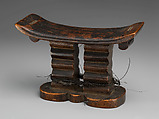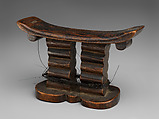Headrest
The use of headrests in southern Africa is ancient and has been traced back to the twelfth-century archaeological site of Mapungubwe, an urban center along the Limpopo River. There, evidence of gold sheeting believed to have adorned a long-disintegrated wooden headrest has been recovered. While headrests were designed to serve a functional purpose--to support the head while sleeping in order to protect elaborate hairstyles--their intimate connection with their owners is such that they are also seen as precious vehicles for communicating with an ancestral realm. In many instances, such artifacts are buried with their owners along with other personal items. The design of such works is reflected in a range of regional styles. Shona sculptors and their neighbors to the southeast, the Tsonga, have been credited with the most varied formal solutions to the carving of the support element.
This image cannot be enlarged, viewed at full screen, or downloaded.
This artwork is meant to be viewed from right to left. Scroll left to view more.




